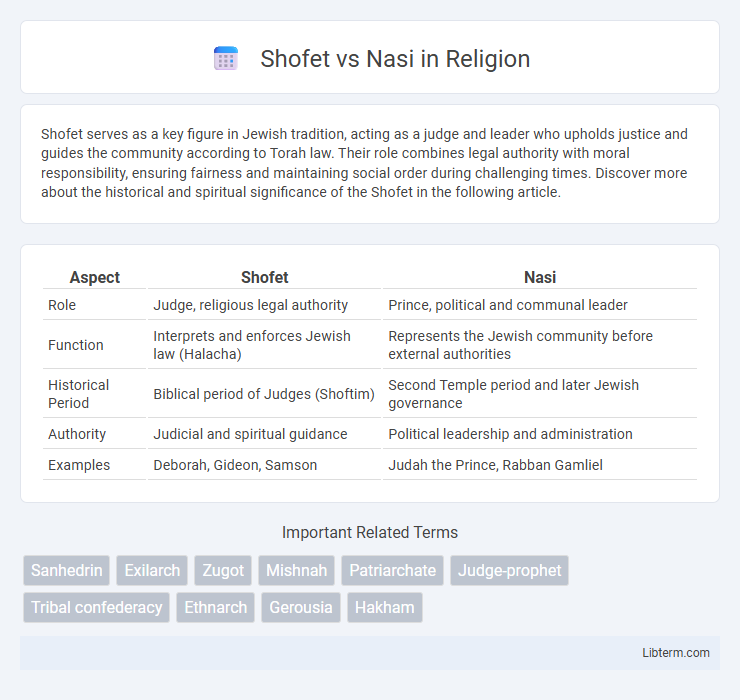Shofet serves as a key figure in Jewish tradition, acting as a judge and leader who upholds justice and guides the community according to Torah law. Their role combines legal authority with moral responsibility, ensuring fairness and maintaining social order during challenging times. Discover more about the historical and spiritual significance of the Shofet in the following article.
Table of Comparison
| Aspect | Shofet | Nasi |
|---|---|---|
| Role | Judge, religious legal authority | Prince, political and communal leader |
| Function | Interprets and enforces Jewish law (Halacha) | Represents the Jewish community before external authorities |
| Historical Period | Biblical period of Judges (Shoftim) | Second Temple period and later Jewish governance |
| Authority | Judicial and spiritual guidance | Political leadership and administration |
| Examples | Deborah, Gideon, Samson | Judah the Prince, Rabban Gamliel |
Introduction to Ancient Jewish Leadership Roles
Shofet and Nasi were distinct leadership roles in ancient Jewish society with unique functions. The Shofet, or judge, primarily exercised judicial authority, overseeing legal disputes and enforcing Mosaic law within the community. The Nasi served as a political and religious leader, often representing the Jewish people in external affairs and guiding communal governance during the Second Temple period.
Understanding the Shofet: Definition and Origins
The Shofet, an ancient Israelite leader, functioned primarily as a judicial and military figure during the period of the Judges, guiding tribes through legal decisions and warfare. Originating from the Hebrew root "shofet," meaning judge, the role emphasized divine authority and community leadership before the establishment of monarchy. Understanding the Shofet's function reveals the decentralized, theocratic governance structure that preceded the centralized rule embodied by the later Nasi, or prince.
The Role and Functions of a Nasi
The Nasi served as the political and religious leader of the Jewish people during the Second Temple period, embodying both judicial authority and communal representation. This role included presiding over the Sanhedrin, heading judicial proceedings, and overseeing religious observance in line with Torah law. The Nasi also played a significant part in diplomatic relations with external powers and guiding the Jewish community through social and legal matters.
Historical Context: Shofet in the Biblical Era
The shofet served as the chief judicial and military leader in ancient Israel during the Biblical era, predating the establishment of a monarchy. This role combined religious authority with governance, guiding the Israelite tribes through periods of conflict and societal organization. Historical records emphasize the shofet's responsibilities in delivering justice, leading battles, and maintaining covenantal laws.
The Nasi in Rabbinic Tradition
The Nasi in rabbinic tradition served as the highest-ranking leader in the Sanhedrin, overseeing judicial functions and communal governance. Unlike the Shofet, who acted primarily as a judge with limited authority, the Nasi held both legislative and executive powers, often guiding synagogue administration and legal interpretation. Historical texts emphasize the Nasi's role in maintaining Jewish unity and religious continuity during periods of Roman rule.
Key Differences Between Shofet and Nasi
The key differences between Shofet and Nasi lie in their roles and authority within ancient Jewish leadership structures. A Shofet functioned primarily as a judge and military leader during the period of the Judges, wielding judicial and executive powers on a tribal level, whereas a Nasi served as a prince or president, often holding a more centralized, political, and religious leadership position in the Sanhedrin or Jewish community, especially during the Second Temple era. Shofet roles were typically temporary and situational, while the Nasi position was more institutionalized and hereditary, reflecting evolving governance models in Jewish history.
Influence and Authority of Shofet and Nasi
The Shofet held judicial and executive authority, acting as the chief judge and military leader with influence rooted in legal and religious decision-making. The Nasi possessed broader political and communal leadership, serving as a prince or president who represented the Jewish people to external powers and coordinated national affairs. Both roles wielded significant influence, with the Shofet focusing on internal justice and governance, while the Nasi concentrated on external diplomacy and overarching political strategy.
Examples of Prominent Shofetim and Nesi’im
Prominent Shofetim include figures like Deborah, who led Israel as a judge and prophetess, and Samson, known for his extraordinary strength and leadership during turbulent times. Notable Nesi'im feature King David, who unified the tribes and established Jerusalem as the capital, and King Solomon, renowned for his wisdom and building the First Temple. These leaders exemplify the distinct roles of Shofetim as military and judicial leaders and Nesi'im as political and spiritual rulers.
Impact on Jewish Governance and Society
The roles of Shofet and Nasi significantly shaped Jewish governance and societal structure by balancing judicial authority and political leadership during the Second Temple period. The Shofet primarily administered justice and religious law, reinforcing legal coherence and social order, while the Nasi held supreme authority as both a political leader and spiritual head, facilitating centralization of communal power. This dual leadership system fostered stability, unity, and resilience within Jewish communities under Roman rule, influencing the evolution of rabbinic governance.
Legacy of Shofet and Nasi in Modern Times
The legacy of the Shofet and Nasi in modern times underscores the evolution of Jewish leadership from ancient judicial and tribal roles to contemporary spiritual and organizational guidance. Shofet, historically associated with delivering justice and leading military efforts, symbolizes the integration of law and communal defense, influencing modern legal and ethical frameworks in Jewish communities. The Nasi's legacy as a prince and political leader has shaped modern Jewish communal administration and religious authority, reflecting continuity in governance and cultural identity.
Shofet Infographic

 libterm.com
libterm.com